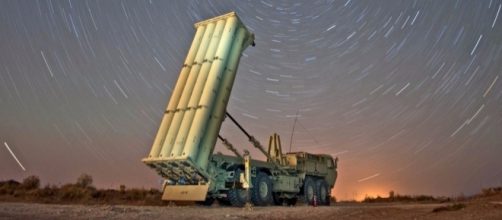President Trump's response to North Korea's ballistic missile tests, the anticipation of a sixth underground nuclear test and their threat to the U.S. and its allies was widely reported as he claimed to send a Naval strike group to the East China Sea. Prior to this, however, the President had also reportedly sent attack drones to the Korean Peninsula and the THAAD anti-missile defense system to South Korea, to protect them from possible incoming missiles from the North. The deployment of the THAAD system was received with controversy since it was agreed to under the former Obama administration.
While the U.S. says that the THAAD system can target incoming short-range missiles with precision, government investigators, scientists and even former Former acting director and deputy director of the CIA Mike Morell are skeptical of the system that protects the U.S. from long-range missiles. According to one report published by NBC news titled: "U.S. May Not Be Able to Shoot Down North Korean Missiles, Say Experts", this system is referred to as the Ground-based Midcourse Defense system (GMD) which uses 60-ft-tall rockets to hit incoming missiles out of the sky in what is usually described as hitting a bullet with another bullet.
GMD capabilities
The article says that the GMD is one of the “heirs” of the Star Wars program that was started under President Ronald Reagan a.k.a the Strategic Defense Initiative.
Should North Korea launch missiles towards the United States, there are apparently 36 systems that are ready to intercept where the distance between both countries is shortest. These locations are in Alaska (32, Ft. Greely) and California (4, Vandenberg Air Force Base) and unlike the Iron Dome system used in Israel which handles short range missiles, the GMD is designed to hit long range missiles in space.
In 2014 during the Israel-Hamas conflict, according to the Israel Defense Forces, of the 2,648 rockets fired at Israel, most were intercepted with a 90 percent success rate. Given the possible threat of long range missiles armed with nuclear warheads; the threat against the U.S. is much greater.
Congress is apparently pushing to add a third site for the GMD on the East Coast as well but at the very earliest, eight more GMD systems will apparently be added by the end of the year. During North Korea's recent celebration where the DPRK held a military parade, experts said they had identified new long-range missiles that has created some concern.
GMD failures
The NBC News article says that the system has already failed to take out their targets six times during nine simulated attacks since the systems were deployed in 2004. Even more, the Government Accountability Office which completed an investigation on the GMD said last year in their report titled: “Missile Defense: Assessment of DOD’s Reports on Status of Efforts and Options for Improving Homeland Missile Defense,” that they did not feel the system had demonstrated that it could defend the U.S.
The article also recalls a 47-page report from last year by the Union of Concerned Scientists that the system's test record was poor and not prepared for real-world conditions. Also, in 2012 the National Academy of Sciences said that the GMD was deficient.
In an April 14 interview with Michael Morell on Charlie Rose, the former intelligence official said that when the North Koreans tested multiple ballistic missiles at once in March and last year, it posed another threat because it showed what they hadn't shown before, that they could fire multiple missiles at their enemies and possibly overwhelm their defense systems. It wasn't clear in the interview which anti-missile defense system he was referring to, but he was likely referring to any defense system being able to intercept one missile.
He said that if the generals were pressed to give assurances to the President, they would not be able to make any guarantees.
Real-world scenario
Various reports on the missile tests conducted by the DPRK say that they have been using solid fuel as opposed to liquid, which provides a level of stealth to the launch of their missiles. It's even been said that vehicles carrying these missiles would also be difficult to track which likely makes the Department of Defense's ability to anticipate an incoming missile more difficult. Michael Morell said that the media often says that the North Koreans might have nuclear capabilities and that they could be fully developed by a certain date.
But by knowing that they've already conducted a series of nuclear tests he said that everyone should believe that they have them now.
He said that they know missiles that are able to hit Washington, California had already been deployed but there are no reports that they've been tested yet, if they've tested them at all. Morell verified that given the difficulties of tracking the mobile missile units and being able to even know by the time a missile is launched, whether they would be able to intercept it on time, is not likely.

